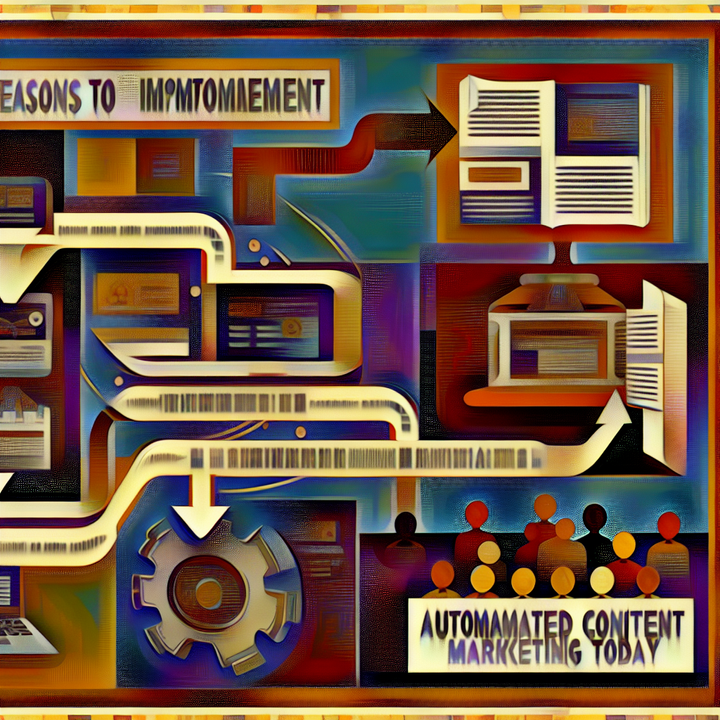Increase Web Traffic with SEO-Optimized Automated Content

Content marketing has evolved significantly over the past decade, largely due to shifts in consumer behavior and advancements in technology. Today, automation is playing a crucial role in reshaping how businesses approach content creation and distribution. Automated content marketing solutions are no longer a luxury but a necessity for businesses looking to maintain a competitive edge in the digital space. This article explores the multifaceted world of automated content marketing, focusing on how it enhances SEO, increases web traffic, and ultimately converts prospects into leads.
The Power of Automated Content in Modern Marketing
Automation in content marketing is not just a trend; it's a game-changer. In a world where online presence is paramount, traditional methods of content creation and management can be slow and resource-intensive. Automated content marketing offers a streamlined approach to ensure that your brand remains relevant without overwhelming your marketing team.
Here are some key trends driving the adoption of automated content solutions:
- Increased Efficiency: Automating repetitive tasks allows your team to focus on strategy and creativity.
- Personalization: AI can analyze user data to create personalized content, enhancing user engagement.
- Real-time Analytics: Immediate feedback on performance metrics enables quick adjustments to your content strategy.
These trends underscore the need for automated content solutions in modern marketing strategies. As the digital landscape continues to evolve, the ability to quickly adapt and maintain a consistent online presence is more important than ever.
Understanding SEO: The Basics Every Business Owner Needs to Know
Search Engine Optimization (SEO) is the practice of optimizing your website to rank higher in search engine results. A strong understanding of SEO principles can significantly boost your online visibility, making it easier for potential customers to find you. Here are the basic components of SEO:
- Keywords: Select and use relevant keywords throughout your content.
- Metadata: Optimize title tags, meta descriptions, and headers to improve click-through rates.
- Backlinks: Acquire links from reputable websites to boost authority.
- Content Relevance: Ensure that your content is valuable and relevant to your target audience.
SEO is crucial for increasing web traffic and improving your website’s search engine rankings. When done correctly, SEO helps your business reach a wider audience and convert more visitors into customers.
How SEO Drives Web Traffic
The relationship between SEO and web traffic is symbiotic. Search engine algorithms consider various factors when ranking websites, including keyword optimization and content quality. Here's how SEO drives web traffic:
| Factor | Impact on Web Traffic |
|---|---|
| Keyword Optimization | Increases visibility in search engine results pages (SERPs), drawing more organic traffic. |
| Quality Content | Engages visitors, encouraging them to spend more time on your site and explore additional pages. |
| User Experience | Improves site navigation and load times, reducing bounce rates and increasing engagement. |
By focusing on these factors, you can create an SEO strategy that boosts your website’s traffic and enhances your overall digital presence.
How Automated Content Marketing Enhances SEO
Automated content marketing solutions offer several advantages that can significantly enhance your SEO efforts. These tools ensure consistency, optimize keywords automatically, and improve metadata and tagging, all without requiring manual intervention.
Consistency in Content Production
One of the cornerstones of effective SEO is regular, high-quality content. Automated systems ensure that your site remains active and up-to-date, which search engines favor. Here’s why consistency is crucial:
- Search engines give preference to websites that are regularly updated.
- Frequent posts keep your audience engaged and coming back for more.
- Consistent content helps in establishing your brand as an authority in your industry.
By maintaining a steady stream of relevant content, automated systems can help you stay ahead in the competitive world of digital marketing.
Automatic Keyword Optimization
Keywords are the backbone of any SEO strategy. Automated tools can seamlessly integrate primary and secondary keywords into your content. They also use Latent Semantic Indexing (LSI) keywords to enhance the contextual relevance of your articles. This automatic optimization ensures that your content is always aligned with current search engine algorithms, improving visibility and ranking.
Improved Metadata and Tagging
Metadata and tags are essential for improving click-through rates and search rankings. Automated tools can optimize these elements to ensure they are aligned with best practices. Here’s how:
- Title Tags: Generate compelling titles that attract clicks and incorporate keywords.
- Meta Descriptions: Craft informative snippets that improve click-through rates from SERPs.
- Alt Text: Optimize image alt text to enhance SEO and accessibility.
This automatic optimization helps ensure that every piece of content you publish is set up for success from the moment it goes live.
Practical Tips for Implementing Automated Content Solutions
Implementing automated content marketing solutions can seem daunting, but with the right approach, it can be a seamless and rewarding process. Below are some practical tips to help you get started:
Choosing the Right Automated Content Platform
Selecting the right platform is crucial for the success of your automated content strategy. Consider these factors:
- Ease of Use: The platform should be user-friendly and intuitive.
- Integration Capabilities: Ensure it can integrate with your existing marketing tools and platforms.
- Performance Analytics: Look for robust analytics to measure the effectiveness of your content.
Taleflow, for example, offers an intuitive platform tailored to different business needs, making it a strong contender for businesses looking to streamline their content marketing efforts.
Setting Up and Customizing Your Content Strategy
The initial setup is crucial for the success of automated content. Follow these steps:
- Identify Your Goals: Know what you want to achieve, whether it’s higher engagement, increased traffic, or more conversions.
- Understand Your Audience: Tailor your content to meet the needs and interests of your target audience.
- Create a Content Calendar: Plan your posts in advance to maintain consistency.
Customization is key. Ensure that your content plan is aligned with your business goals, industry standards, and the unique demands of your target audience.
Monitoring and Measuring Performance
Tracking the effectiveness of your automated content is essential for continuous improvement. Important KPIs (Key Performance Indicators) to monitor include:
- Website Traffic: Track the number of visitors and their behavior on your site.
- Engagement Metrics: Measure likes, shares, comments, and other forms of engagement.
- Conversion Rates: Monitor how many visitors are converting into leads or customers.
Use these insights to refine your content strategy continually. Remember, the goal is not just to create content but to create effective content that drives results.
Case Studies: Success Stories of Automated Content Implementation
Real-life examples can illustrate the benefits of automated content marketing. Here are a few success stories:
Case Study 1: Elite Tech Solutions
By integrating Taleflow’s automated blog service, Elite Tech Solutions saw a 40% increase in organic traffic within three months. The consistency and quality of the posts significantly improved their SEO performance.
Case Study 2: HealthFirst Clinics
HealthFirst Clinics utilized newsletter automation to keep their patients informed. The tailored content led to a 25% increase in patient engagement and a noticeable uptick in appointment bookings.
These examples highlight the potential of automated content marketing solutions to deliver tangible results.
Addressing Common Concerns and Misconceptions About Automated Content
Despite its many benefits, some businesses are hesitant to adopt automated content marketing due to common misconceptions. It's important to address these concerns to make an informed decision.
Quality Versus Quantity
A common misconception is that automated content sacrifices quality for quantity. However, modern tools, like those provided by Taleflow, utilize sophisticated algorithms to ensure high-quality output. Here are some ways automated content can maintain quality:
- AI-driven content checks for grammar and coherence.
- Customized templates ensure consistent voice and tone.
- Regular updates to algorithms maintain alignment with SEO best practices.
This ensures that automated content is not only frequent but also of high quality.
Ensuring Content Uniqueness
Another concern is the uniqueness of automated content. Advanced AI tools can generate unique content for each post, avoiding repetitiveness and maintaining SEO standards. Here’s how:
- Spinning existing content to create new, unique articles.
- Using extensive databases to generate fresh content ideas.
- Incorporating real-time data and trends to keep content current.
These mechanisms ensure that your content remains unique and engaging.
Future of Automated Content Marketing
The future of automated content marketing looks promising, driven by advancements in technology such as AI, machine learning, and Natural Language Processing (NLP). These technologies are set to revolutionize content strategies further.
Emerging Technologies in Content Automation
Several emerging technologies are poised to take automated content marketing to the next level:
- AI-Driven Content Creation: AI can now create entire articles that are coherent and engaging, reducing the need for human intervention.
- NLP: Advances in NLP allow for more natural and human-like text generation.
- Advanced Data Analytics: Enhanced analytics provide deeper insights into user behavior and content performance.
These innovations will enable businesses to create more personalized, effective, and engaging content, further simplifying content marketing automation.
Preparing Your Business for Future Trends
Adapting to future trends in automated content marketing is crucial for sustained success. Here’s how you can prepare:
- Stay Updated: Keep an eye on emerging technologies and trends.
- Experiment: Don’t be afraid to try new tools and strategies.
- Educate Your Team: Ensure that your team is knowledgeable about the latest in content marketing automation.
By staying proactive and adaptable, your business can remain ahead of the curve and continuously reap the benefits of automated content marketing.
In conclusion, automated content marketing offers a streamlined, efficient, and effective way to enhance SEO, increase web traffic, and convert prospects into leads. By understanding its capabilities and implementing best practices, businesses can unlock the full potential of automated content solutions, ensuring a sustainable and successful content marketing strategy.



